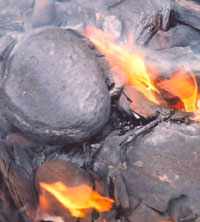
Oil shale, an organic-rich fine-grained sedimentary rock, contains significant amounts of kerogen (a solid mixture of organic chemical compounds) from which technology can extract liquid hydrocarbons. The name oil shale represents a double misnomer, as geologists would not necessarily classify the rock as a shale, and its kerogen differs from crude oil. Kerogen requires more processing to use than crude oil, which increases its cost as a crude-oil substitute both financially and in terms of its environmental impact. Deposits of oil shale occur around the world, including major deposits in the United States of America. Estimates of global deposits range from 2.8 trillion to 3.3 trillion barrels (450 × 109 to 520 × 109 m3) of recoverable oil.
The chemical process of pyrolysis can convert the kerogen in oil shale into synthetic crude oil. Heating oil shale to a sufficiently high temperature will drive off a vapor which processing can distill (retort) to yield a petroleum-like shale oil—a form of unconventional oil—and combustible oil-shale gas (the term shale gas can also refer to gas occurring naturally in shales). Industry can also burn oil shale directly as a low-grade fuel for power generation and heating purposes and can use it as a raw material in chemical and construction-materials processing.
Oil shale has gained attention as an energy resource as the price of conventional sources of petroleum has risen and as a way for some areas to secure independence from external suppliers of energy. At the same time, oil-shale mining and processing involve a number of environmental issues, such as land use, waste disposal, water use, waste-water management, greenhouse-gas emissions and air pollution. Estonia and China have well-established oil shale industries, and Brazil, Germany, Israel and Russia also utilize oil shale.
Geology
Oil shale, an organic-rich sedimentary rock, belongs to the group of sapropel fuels. It does not have a definite geological definition nor a specific chemical formula, and its seams do not always have discrete boundaries. Oil shales vary considerably in their mineral content, chemical composition, age, type of kerogen, and depositional history. Oil shale differs from bitumen-impregnated rocks (oil sands and petroleum reservoir rocks), humic coals and carbonaceous shale. While oil sands originate from the biodegradation of oil, heat and pressure have not (yet) transformed the kerogen in oil shale into petroleum.
Oil shale contains a lower percentage of organic matter than coal. In commercial grades of oil shale the ratio of organic matter to mineral matter lies approximately between 0.75:5 and 1.5:5. At the same time, the organic matter in oil shale has an atomic ratio of hydrogen to carbon (H/C) approximately 1.2 to 1.8 times lower than for crude oil and about 1.5 to 3 times higher than for coals. The organic components of oil shale derive from a variety of organisms, such as the remains of algae, spores, pollen, plant cuticles and corky fragments of herbaceous and woody plants, and cellular debris from other aquatic and land plants. Some deposits contain significant fossils; Germany's Messel Pit has the status of a Unesco World Heritage Site. The mineral matter in oil shale includes various fine-grained silicates and carbonates.
Geologists can classify oil shales on the basis of their composition as carbonate-rich shales, siliceous shales, or cannel shales. Another classification, known as the van Krevelen diagram, assigns kerogen types, depending on the hydrogen, carbon, and oxygen content of oil shales' original organic matter. The most commonly used classification of oil shales, developed between 1987 and 1991 by Adrian C. Hutton of the University of Wollongong, adapts petrographic terms from coal terminology. This classification designates oil shales as terrestrial, lacustrine (lake-bottom-deposited), or marine (ocean bottom-deposited), based on the environment of the initial biomass deposit. Hutton's classification scheme has proven useful in estimating the yield and composition of the extracted oil.
From http://en.wikipedia.org/
Ear Force X41 (XBOX LIVE Chat + Wireless Digital RF Game Audio with Dolby
Headphone 7.1 Surround Sound)
-
Ear Force X41 (XBOX LIVE Chat + Wireless Digital RF Game Audio with Dolby
Headphone 7.1 Surround Sound)
by Turtle Beach
[image: Ear Force X41 (XBOX LIVE C...




0 comments:
Post a Comment